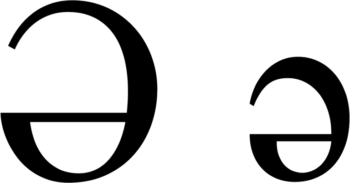Cos’è lo schwa? Posted by Bridgette on Oct 9, 2020 in Grammar, Italian Language
Ciao di nuovo!
Cos’è lo schwa? What is the ‘schwa’? If you’re not a linguist, you probably have never heard or seen it. Merriam-Webster dictionary defines it as follows; an unstressed mid-central vowel (such as the usual sound of the first and last vowels of the English word America).
This sound is represented by the symbol below in the Alfabeto Fonetico Internazionale (International Phonetic Alphabet – IPA) which is the most widely used system for representing the sounds of any language. Yes, those strange looking symbols in the dictionary next to words are from the IPA!

So the schwa is quite integral to the English language – from the a in about (a proposito) to the u in survive (sopravvivere). But we also see it in some dialects of Italian, such as Neapolitan, a final, unstressed ⟨a⟩, and unstressed ⟨e⟩ and ⟨o⟩ are pronounced as a schwa: pìzza (‘pizza’) and semmàna (‘week’).
Per una spiegazione perfetta in Italiano da un madrelingua inglese, ecco un video:
So now that we know what schwa is, how exactly does it relate to Italian? Allora, in Italia oggi c’è un dibattito per una lingua italiana più inclusiva. Well, in Italy today there is a debate for a more inclusive language.
Quindi, lo schwa è un simbolo citato sempre per una lingua italiana più inclusiva e meno legata al predominio del genere maschile. Therefore, the schwa is a symbol always cited for a more inclusive Italian language and less linked to the dominance of the male gender.
La linguista italiana Vera Gheno wrote on her Facebook about some suggestions as to how to make Italian more inclusive, in addition to the possible use of the schwa. Here is what she wrote:
Censimento: soluzioni in uso per gestire la “moltitudine mista”. Elenco quelle che vengono in mente a me, aggiungetene pure altre nei commenti, sia esistenti sia proponibili.
– Il maschile sovraesteso: Cari tutti, siamo qui riuniti…
– La doppia forma: Care tutte e cari tutti, siamo qui riunite e riuniti…
– La circonlocuzione: Care persone qui riunite…
– Il femminile sovraesteso: Care tutte, siamo qui riunite…
– La u: Caru tuttu, siamo qui riunitu…
– L’omissione dell’ultima lettera: Car tutt, siamo qui riunit…
– Il trattino basso: Car_ tutt_, siamo qui riunit_…
– L’asterisco: car* tutt*, siamo qui riunit*…
– L’@: car@ tutt@, siamo qui riunit@…
– Lo schwa: Carə tuttə, siamo qui riunitə…
– La x: Carx tuttx, siamo qui riunitx…
– La y: Cary tutty, siamo qui riunity…
– Il mix: Carei tuttei, siamo qui riunitei…
– Il mix puntato: Care.i tutte.i, siamo qui riunite.i…
– La barra: Care/i tutte/i, siamo qui riunite/i…
– L’apostrofo: Car’ tutt’, siamo qui riunit’…
The source can be found here.
She continues on her Facebook to discuss why she believes this to be an important topic to consider. You can read her whole post here. If you wouldn’t like to read the whole thing, here is an interesting excerpt I’d like to highlight:
- Che piaccia o no alla “maggioranza”, esistono persone che al momento ritengono l’esistenza dei generi maschile e femminile come un limite all’espressione di sé, anche solo nel rivolgersi a una moltitudine mista, che la norma prevede di appellare usando il maschile sovraesteso. Decidere “a tavolino” che questo disagio non esista o non sia degno di attenzione è, a mio avviso, un atteggiamento superficiale; e non è necessario che il suo contrario venga bollato per forza come un eccesso di “politicamente corretto”.
- Nessuno può prevedere dove porteranno queste riflessioni, se avranno qualche ricaduta duratura sulla lingua italiana o se spariranno nel giro di poco. Ma questo non toglie che se ne possa parlare, senza bisogno di arrocchi sdegnosi. Il mondo, per quanto mi riguarda, può solo essere più bello se è più vario, e l’unico modo per escogitare eventuali soluzioni “inclusive” (anche se non amo questo termine, perché sembra presumere che ci siano persone che includono e persone che vengono incluse) è di rifletterci assieme, senza estremizzazioni né da una parte né dall’altra.
Feel free to let me know your thoughts in the comments, but please keep it polite. Regardless of your personal opinions on the matter, inclusivity does make for an interesting linguistic challenge for languages that are gender based such as Italian! And remember, languages are “alive” and always changing, and I personally find that half the fun and half the challenge. 🙂
Alla prossima raggazə!

Build vocabulary, practice pronunciation, and more with Transparent Language Online. Available anytime, anywhere, on any device.




Comments:
Frank M Baglione:
Language changes, yes, but changing language for political or social ideologies is silly. If the author wants inclusivity, then stop using the feminine “Lei” for the polite form of “you” in the singular.
La lingua cambia, sì, ma cambiare la lingua per le ideologie politiche o sociali è sciocco. Se l’autore vuole inclusività, smetti di usare il femminile “Lei” per la forma gentile di “tu” al singolare.
Joe:
Hi Bridgette,
This was excellent! Thank you. Joe
Giacomo:
Mi piace molto l’articolo Lo Slang Italiano!
Grazie, Brigette per tutto fa per farci meglio informato sul la lingua Italiana. Mia moglie ed Io
particolarmente godere gli articoli con un brano in italiano and lo stesso in inglese. É bello per noi studiare in quel modo.
Cosi, Grazie di nuovo.
giacomo